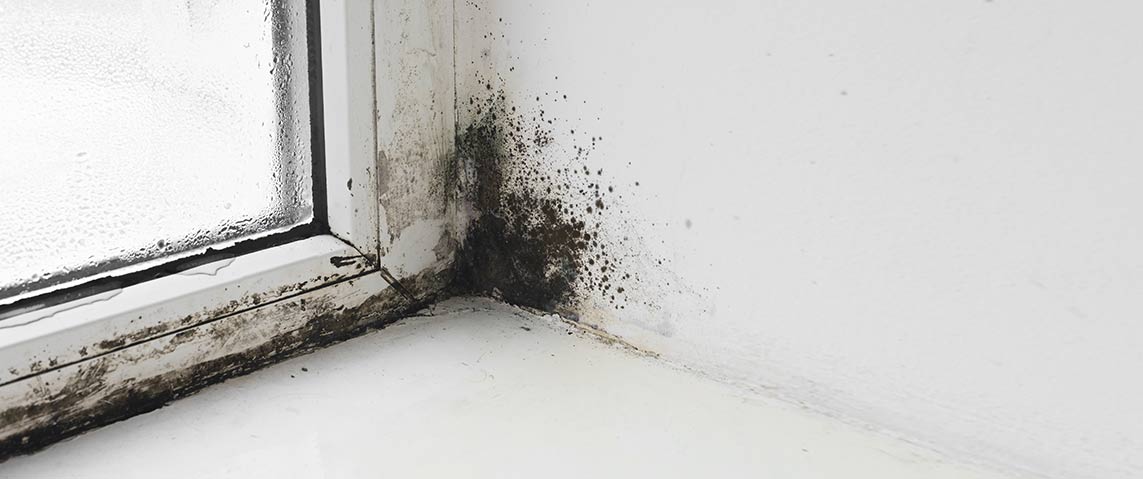How to Get Rid of Black Mould?

Black mould is a common problem in many UK homes, and it can be unsightly, unhealthy, and difficult to get rid of. Black mould thrives in damp, warm, and humid environments and can cause respiratory problems, allergic reactions, and other health issues. Here are some tips on how to get rid of black mould in your home.
Before you can effectively tackle black mould, you need to identify the source of the problem. Black mould often grows in areas that are damp, such as bathrooms, kitchens, and basements. Look for areas where water is present, such as around sinks, toilets, showers, and pipes. Leaking roofs, windows, and pipes can also contribute to black mould growth.
Clean the Affected Area
Once you have identified the source of the problem, it's time to clean the affected area. Use a mixture of bleach and water or a commercial mould and mildew remover to clean the area thoroughly. Wear gloves and a mask to protect yourself from exposure to the mould spores.
Dry the Area
After cleaning the affected area, it's important to dry it thoroughly to prevent black mould from returning. Use a dehumidifier or fan to dry the area, and keep the room well-ventilated to allow air to circulate. This will help prevent moisture from accumulating and reduce the risk of black mould growth.
Identify and Fix the Underlying Problem
Getting rid of black mould is not enough if the underlying problem is not addressed. Identify and fix any leaks or sources of excess moisture that contributed to the black mould growth. Fixing the problem will prevent black mould from returning and help ensure a healthy living environment.
Preventative Measures
To prevent black mould from returning, there are several preventative measures you can take. Keep the home well-ventilated, use a dehumidifier in damp areas, and fix any leaks or water damage promptly. Regularly cleaning and disinfecting surfaces can also help prevent black mould growth.
Seek Professional Help
If the black mould problem is extensive or if you are unsure about how to tackle it, seek professional help. A professional mould remediation company can assess the extent of the problem, identify the underlying causes, and provide effective solutions to get rid of black mould and prevent it from returning.
Use Natural Remedies
In addition to commercial mould and mildew removers, there are several natural remedies you can use to get rid of black mould. Vinegar is a natural disinfectant and can be used to kill mould spores. Simply spray white vinegar onto the affected area and let it sit for an hour before wiping it clean with a damp cloth. Tea tree oil is another effective natural remedy for black mould. Mix a teaspoon of tea tree oil with a cup of water and spray the mixture onto the affected area. Leave it for an hour before wiping it clean.
Use Protective Equipment
When cleaning black mould, it's important to wear protective equipment to prevent exposure to mould spores. Wear gloves, a mask, and eye protection to protect yourself from exposure. If you have respiratory problems or are sensitive to chemicals, consider using a respirator or hiring a professional mould remediation company.
Dispose of Contaminated Materials
If any materials such as carpet, drywall, or insulation are contaminated with black mould, they may need to be disposed of. Mould can penetrate porous materials and can be difficult to remove completely. Contaminated materials should be sealed in a plastic bag and disposed of in accordance with local regulations.
Maintain Good Hygiene
Maintaining good hygiene is important for preventing black mould growth. Clean and disinfect surfaces regularly, especially in areas prone to moisture, such as bathrooms and kitchens. Wash and dry towels and other fabrics thoroughly to prevent moisture buildup. Use a squeegee or towel to dry shower walls and curtains after use to prevent water from accumulating.
Monitor for Signs of Recurrence
After cleaning black mould, it's important to monitor the affected area for signs of recurrence. Keep an eye out for any new growth or musty odours. If you notice any signs of black mould returning, take action immediately to prevent it from spreading.
Consider Professional Testing
If you suspect that your home has a black mould problem, consider professional testing to identify the extent of the problem. A professional mould testing company can perform air and surface sampling to determine the type and amount of mould present. This can help you determine the best course of action for getting rid of black mould and preventing it from returning.
In conclusion, getting rid of black mould requires a combination of cleaning, drying, fixing underlying problems, and preventative measures. Using natural remedies, wearing protective equipment, and disposing of contaminated materials can all help in the process. Maintaining good hygiene and monitoring for signs of recurrence are also important. If you are unsure about how to tackle a black mould problem, seek professional help. With these tips, you can effectively get rid of black mould and create a healthy living environment in your home.
You can check more information on our Plumbing & Drainage Insurance Cover and even can contact us directly if you want to have any other home emergency insurance.
Transform the aesthetics of your space with our blog, 'How to Cover Pipes on Wall.' Dive into a comprehensive guide offering practical insights and step-by-step instructions to effortlessly conceal unsightly pipes.
Empower yourself with our blog, 'How to Detect Water Leak at Home,' as we unveil the secrets to safeguarding your property. Explore expert tips and DIY techniques to pinpoint and address water leaks efficiently.

 Home Emergency
Home Emergency 
 Home Appliances
Home Appliances 
 Landlord Home Emergency
Landlord Home Emergency 





 Motor Breakdown Cover
Motor Breakdown Cover 


 Infotainment
Infotainment 

 Home Emergency Insurance
Home Emergency Insurance Home Appliance Insurance
Home Appliance Insurance Landlord Home Emergency
Landlord Home Emergency TV Brands
TV Brands